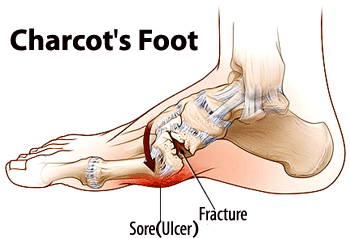Charcot Joint in Diabetes – what to promptly act?
People with diabetes suffer from many chronic complications. One of the most debilitating complications is the Charcot joint. This less popular complication is caused by nerve damage that often occurs in patients with diabetes. The aim of this article is to provide an overview of the Charcot joint thus people with diabetes become more aware with it thus may act promptly when its symptoms occur.
Contents
Introduction
In 1868, Jean Martin-Charcot is the first physician who describes this condition, which later bears his name. It is a constellation of signs and symptoms that afflict many people with diabetes, mostly at their foot. Approximately 10% of people with diabetes suffer from it. However, many go undetected. The causes of this disorder are multifactorial, but all of the involved factors link to the so-called neuropathy, an impairment of nerve function. This disorder results in less sensitive foot, making the people with diabetes more prone to injury. The nerve that controls your small vessel also got impaired. This lead to vascular dilatation, resulting in increased blood flow to the foot and edema. The increased blood flow may cause your bone become thinner and weaker, thus lowering the overall strength of the foot.
Signs and Symptoms
 The earliest sign and symptoms of Charcot joint can vary. Started as a mild swelling, redness and a localized increase in skin temperature, it may turn into fracture, dislocation, foot collapse, deformity and ulceration. Making it more complicated, the early stage may resemble skin infection or bone infection, which often occurs in people with diabetes.
The earliest sign and symptoms of Charcot joint can vary. Started as a mild swelling, redness and a localized increase in skin temperature, it may turn into fracture, dislocation, foot collapse, deformity and ulceration. Making it more complicated, the early stage may resemble skin infection or bone infection, which often occurs in people with diabetes.
Typically, Charcot joint present in patient with long standing of diabetes (10-15 years duration). Many of the afflicted are in their sixth decade of live. The remarkable features are the deformity is painless and not traumatic in origin.
Act now
When you find the signs and symptoms mentioned above, you must act quickly. A wait-and-see approach will prove to be disastrous. Get an appointment with your doctor immediately. It is better to raise a false alarm than to let this condition goes unnoticed and thus worsen. The most important parts of Charcot joint management are early detection and prompt action.
What to expect
After telling your condition, your doctor will calm you while assess your foot condition thoroughly. A good doctor will not take your complaints lightly. Some examination will be ordered to rule in or rule out the presence of Charcot joint. Typical examination involves taking x-ray of your foot. Blood exam may be ordered to assess the possibility of infection. Potentially confused with skin infection and bone infection, more sophisticated examination, such as Magnetic Resonance Imaging (MRI) and Positron Emission Tomography (PET) may be ordered.
The main management of Charcot joint involves non-weight bearing. Initially the management involves immobilization of the affected limb, and then the patients will learn to use walker, brace or contact cast once the swelling begin to subside. The patient may walk safely without aid after approximately 4-6 months.

